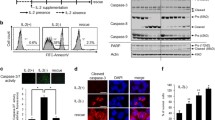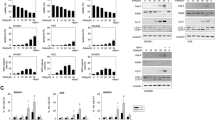Abstract
We have previously shown that activation of the acid sphingomyelinase (ASM), the release of ceramide and the formation of ceramide-enriched membrane domains are central for the induction of apoptosis by CD95. Here, we demonstrate that tumor necrosis factor-related apoptosis-inducing ligand (TRAIL) and CD95 activate the ASM via a redox mechanism resulting in release of ceramide and formation of ceramide-enriched membrane platforms. Ceramide-enriched membrane platforms serve to cluster DR5 upon stimulation. Antioxidants prevent TRAIL-mediated stimulation of ASM, the release of ceramide, the formation of ceramide-enriched membrane platforms and the induction of apoptosis by TRAIL. Further, ASM-deficient splenocytes fail to cluster DR5 in ceramide-enriched membrane domains upon TRAIL stimulation and resist TRAIL-induced apoptosis, events that were restored by addition of natural C16-ceramide. A dose–response analysis indicates that ceramide-enriched membrane platforms greatly sensitized tumor cells to TRAIL-induced apoptosis. Our data indicate that ceramide-enriched membrane platforms are required for the signaling of TRAIL-DR5 complexes under physiological conditions.








Similar content being viewed by others
References
Abdel Shakor AB, Kwiatkowska K, Sobota A . (2004). J Biol Chem 279: 36778–36787.
Andrieu-Abadie N, Jaffrezou JP, Hatem S, Laurent G, Levade T, Mercadier JJ . (1999). FASEB J 13: 1501–1510.
Aouad SM, Cohen LY, Sharif-Askari E, Haddad EK, Alam A, Sekaly RP . (2004). J Immunol 172: 2316–2323.
Ashkenazi A, Pai RC, Fong S, Leung S, Lawrence DA, Marsters SA et al. (1999). J Clin Invest 104: 155–162.
Belka C, Gruber C, Jendrossek V, Wesselborg S, Budach W . (2004). Int J Radiat Oncol Biol Phys 58: 542–554.
Belka C, Marini P, Lepple-Wienhues A, Budach W, Jekle A, Los M et al. (1999). Oncogene 18: 4983–4992.
Belka C, Schmid B, Marini P, Durand E, Rudner J, Faltin H et al. (2001). Oncogene 20: 2190–2196.
Bhardwaj A, Aggarwal BB . (2003). J Clin Immunol 23: 317–332.
Bock J, Gulbins E . (2003). FEBS Lett 534: 169–174.
Boniface JJ, Rabinowitz JD, Wulfing C, Hampl J, Reich Z, Altman JD et al. (1998). Immunity 9: 459–466.
Brown DA, London E . (1998). J Membr Biol 164: 103–114.
Chan FK, Chun HJ, Zheng L, Siegel RM, Bui KL, Lenardo MJ . (2000). Science 288: 2351–2354.
Cremesti A, Paris F, Grassme H, Holler N, Tschopp J, Fuks Z et al. (2001). J Biol Chem 276: 23954–23961.
Degli-Esposti MA, Dougall WC, Smolak PJ, Waugh JY, Smith CA, Goodwin RG . (1997). Immunity 7: 813–820.
Delmas D, Rebe C, Lacour S, Filomenko R, Athias A, Gambert P et al. (2003). J Biol Chem 278: 41482–41490.
Delmas D, Rebe C, Micheau O, Athias A, Gambert P, Grazide S et al. (2004). Oncogene 23: 8979–8986.
Delpy E, Hatem SN, Andrieu N, de Vaumas C, Henaff M, Rucker-Martin C et al. (1999). Cardiovasc Res 43: 398–407.
El-Zawahry A, McKillop J, Voelkel-Johnson C . (2005). BMC Cancer 5: 2.
Emery JG, McDonnell P, Burke MB, Deen KC, Lyn S, Silverman C et al. (1998). J Biol Chem 273: 14363–14367.
Eramo A, Sargiacomo M, Ricci-Vitiani L, Todaro M, Stassi G, Messina CG et al. (2004). Eur J Immunol 34: 1930–1940.
Esen M, Schreiner B, Jendrossek V, Lang F, Fassbender K, Grassme H et al. (2001). Apoptosis 6: 431–439.
Fanzo JC, Lynch MP, Phee H, Hyer M, Cremesti A, Grassme H et al. (2003). Cancer Biol Ther 2: 392–395.
Field KA, Holowka D, Baird B . (1995). Proc Natl Acad Sci USA 92: 9201–9205.
Fulda S, Debatin KM . (2004). Biochim Biophys Acta 1705: 27–41.
Grassme H, Cremesti A, Kolesnick R, Gulbins E . (2003). Oncogene 22: 5457–5470.
Grassme H, Gulbins E, Brenner B, Ferlinz K, Sandhoff K, Harzer K et al. (1997). Cell 91: 605–615.
Grassme H, Jekle A, Riehle A, Schwarz H, Berger J, Sandhoff K et al. (2001b). J Biol Chem 276: 20589–20596.
Grassme H, Jendrossek V, Bock J, Riehle A, Gulbins E . (2002). J Immunol 168: 298–307.
Grassme H, Jendrossek V, Riehle A, von Kurthy G, Berger J, Schwarz H et al. (2003). Nat Med 9: 322–330.
Grassme H, Schwarz H, Gulbins E . (2001a). Biochem Biophys Res Commun 284: 1016–1030.
Graziadei L, Riabowol K, Bar-Sagi D . (1990). Nature 347: 396–400.
Gulbins E, Brenner B, Schlottmann K, Welsch J, Heinle H, Koppenhoefer U et al. (1996). Immunology 89: 205–212.
Gulbins E, Kolesnick R . (2000). Methods Enzymology 322: 382–388.
Hayakawa Y, Screpanti V, Yagita H, Grandien A, Ljunggren HG, Smyth MJ et al. (2004). J Immunol 172: 123–129.
Hueber AO, Bernard AM, Herincs Z, Couzinet A, He HT . (2002). EMBO Rep 3: 190–196.
Janssen EM, Droin NM, Lemmens EE, Pinkoski MJ, Bensinger SJ, Ehst BD et al. (2005). Nature 434: 88–93.
Jendrossek V, Hammersen K, Erdlenbruch B, Kugler W, Krugener R, Eibl H et al. (2002). Cancer Chemother Pharmacol 50: 71–79.
Jendrossek V, Muller I, Eibl H, Belka C . (2003). Oncogene 22: 2621–2631.
Lacour S, Hammann A, Grazide S, Lagadic-Gossmann D, Athias A, Sergent O et al. (2004). Cancer Res 64: 3593–3598.
Liu P, Ying Y, Ko YG, Anderson RG . (1996). J Biol Chem 271: 10299–10303.
Mariani SM, Matiba B, Armandola EA, Krammer PH . (1997). J Cell Biol 137: 221–229.
Morita Y, Perez GI, Paris F, Miranda SR, Ehleiter D, Haimovitz-Friedman A et al. (2000). Nat Med 6: 1109–1114.
Nurminen TA, Holopainen JM, Zhao H, Kinnunen PK . (2002). J Am Chem Soc 124: 12129–12134.
Pan G, Ni J, Wei YF, Yu G, Gentz R, Dixit VM . (1997). Science 277: 815–818.
Pan G, O'Rourke K, Chinnaiyan AM, Gentz R, Ebner R, Ni J et al. (1997). Science 276: 111–113.
Qiu H, Edmunds T, Baker-Malcolm J, Karey KP, Estes S, Schwarz C et al. (2003). J Biol Chem 278: 32744–32752.
Reinehr R, Becker S, Eberle A, Grether-Beck S, Haussinger D . (2005). J Biol Chem 280: 27179–27194.
Rohn TA, Wagenknecht B, Roth W, Naumann U, Gulbins E, Krammer PH et al. (2001). Oncogene 20: 4128–4137.
Rosenman SJ, Ganji AA, Tedder TF, Gallatin WM . (1993). J Leukoc Biol 53: 1–10.
Scheel-Toellner D, Wang K, Assi LK, Webb PR, Craddock RM, Salmon M et al. (2004a). Biochem Soc Trans 32: 679–681.
Scheel-Toellner D, Wang K, Craddock R, Webb PR, McGettrick HM, Assi LK et al. (2004b). Blood 104: 2557–2564.
Scheel-Toellner D, Wang K, Singh R, Majeed S, Raza K, Curnow SJ et al. (2002). Biochem Biophys Res Commun 297: 876–879.
Schneider P, Holler N, Bodmer JL, Hahne M, Frei K, Fontana A et al. (1998). J Exp Med 187: 1205–1213.
Sheridan JP, Marsters SA, Pitti RM, Gurney A, Skubatch M, Baldwin D et al. (1997). Science 277: 818–821.
Siegel RM, Frederiksen JK, Zacharias DA, Chan FK, Johnson M, Lynch D et al. (2000). Science 288: 2354–2357.
Simons K, Ikonen E . (1997). Nature 387: 569–572.
Um HD, Orenstein JM, Wahl SM . (1996). J Immunol 156: 3469–3477.
Ursini-Siegel J, Zhang W, Altmeyer A, Hatada EN, Do RK, Yagita H et al. (2002). J Immunol 169: 5505–5513.
Vidalain PO, Azocar O, Servet-Delprat C, Rabourdin-Combe C, Gerlier D, Manie S . (2000). EMBO J 19: 3304–3313.
Viola A, Schroeder S, Sakakibara Y, Lanzavecchia A . (1999). Science 283: 680–682.
Voelkel-Johnson C, Hannun YA, El-Zawahry A . (2005). Mol Cancer Ther 4: 1320–1327.
Walczak H, Degli-Esposti MA, Johnson RS, Smolak PJ, Waugh JY, Boiani N et al. (1997). EMBO J 16: 5386–5397.
Walczak H, Krammer PH . (2000). Exp Cell Res 256: 58–66.
Walczak H, Miller RE, Ariael K, Gliniak B, Griffith TS, Kubin M et al. (1999). Nat Med 5: 157–163.
Wiley SR, Schooley K, Smolak PJ, Din WS, Huang CP, Nicholl JK et al. (1995). Immunity 3: 673–682.
Wu GS, Burns TF, Zhan Y, Alnemri ES, El-Deiry WS . (1999). Cancer Res 59: 2770–2775.
Yamada H, Tada-Oikawa S, Uchida A, Kawanishi S . (1999). Biochem Biophys Res Commun 265: 130–133.
Yin XM . (2005). Hepatology 42: 956–958.
Acknowledgements
The studies were supported by the Association of International Cancer Research, Deutsche Krebshilfe grant 10-2238-Gu2, DFG-grant Gu 335/13-1 and the Graduiertenkolleg 1045/1 to EG.
Author information
Authors and Affiliations
Corresponding author
Rights and permissions
About this article
Cite this article
Dumitru, C., Gulbins, E. TRAIL activates acid sphingomyelinase via a redox mechanism and releases ceramide to trigger apoptosis. Oncogene 25, 5612–5625 (2006). https://doi.org/10.1038/sj.onc.1209568
Received:
Revised:
Accepted:
Published:
Issue Date:
DOI: https://doi.org/10.1038/sj.onc.1209568
- Springer Nature Limited
Keywords
This article is cited by
-
The acid sphingomyelinase/ceramide system in COVID-19
Molecular Psychiatry (2022)
-
Contribution of specific ceramides to obesity-associated metabolic diseases
Cellular and Molecular Life Sciences (2022)
-
Acid sphingomyelinase-dependent autophagic degradation of GPX4 is critical for the execution of ferroptosis
Cell Death & Disease (2021)
-
Elucidation for modulation of death receptor (DR) 5 to strengthen apoptotic signals in cancer cells
Archives of Pharmacal Research (2019)
-
γ-Tocotrienol induces apoptosis in pancreatic cancer cells by upregulation of ceramide synthesis and modulation of sphingolipid transport
BMC Cancer (2018)




